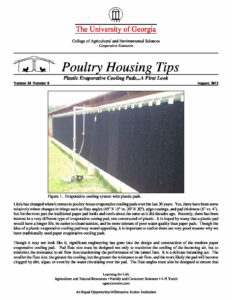.....Little has changed when it comes to poultry house evaporative cooling pads over the last 30 years. Yes, there have been some relatively minor changes in things such as flute angles (45o X 15o vs. 30o X 30o), edge coatings, and pad thickness (6" vs. 4"), but for the most part the traditional paper pad looks and cools about the same as it did decades ago. Recently, there has been interest in a very different type of evaporative cooing pad, one constructed of plastic. It is hoped by many th...at a plastic pad would have a longer life, be easier to clean/sanitize, and be more tolerant of poor water quality than paper pads. Though the idea of a plastic evaporative cooling pad may sound appealing, it is important to realize there are very good reasons why we have traditionally used paper evaporative cooling pads.
To better understand the differences between plastic and paper pads, a study is currently being conducted using a plastic pad that has been installed in a number of poultry houses overseas as well as swine houses here in the US (Big Dutchman PP150-3 http://www.bigdutchmanusa.com/environment/environment/cooling/rainmaker....). The traditional paper pads on a 40' X 500' tunnel-ventilated broiler house in North Georgia were replaced with plastic pads in June of 2011. The five-foot-tall, 6" thick plastic pad is manufactured in two-foot sections and fits in most conventional paper pad evaporative cooling systems. Furthermore, since the pad was designed to have the similar air flow/static pressure characteristics of traditional paper pads, pad area requirements are the same for a house with the plastic pad as they are for a house with traditional six-inch paper pads. To help evenly distribute water along the top of the pad, a two inch thick paper distribution pad was placed on the top of the pad....
Details
| Year | Volume | Number | Categories |
|---|---|---|---|
| 2012 | 24 | 8 |

